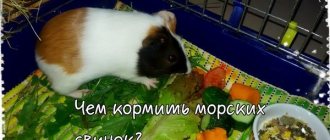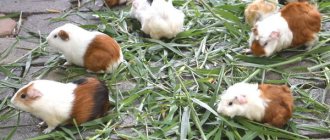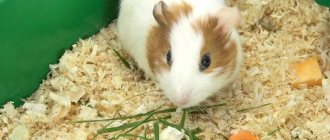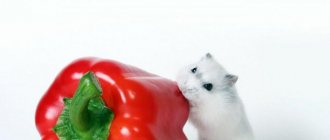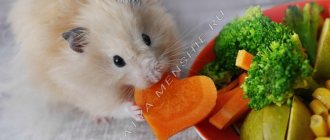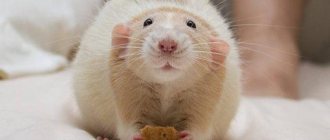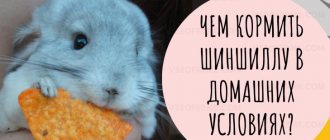What herb will benefit guinea pigs. What plants can be introduced into the diet of pets. Benefits for the body. What herbs are prohibited to give, what are the dangers. What herbs should be given fresh? How to dry grass correctly.
Grass is the main food for a guinea pig, so it is very important to know which plants benefit your pet’s body and which can be harmful and have a negative impact on health.
A variety of plants are rich in vitamins and microelements, and are the main sources of nutrients. Next, we will look in detail at which herbs should be included in your pets’ diet, and which ones are prohibited.
What food to give your guinea pig
Guinea pigs eat a variety of foods and greens. According to the recommendations of experienced specialists, the pet’s diet should be varied and balanced. ½ of the total menu should be hay. The remaining 50% of the diet is dry food, succulent food and greens.
Dry food
Dry food includes grain crops and factory-produced granulated mixtures (special food for domestic guinea pigs).
Healthy grain feeds:
- millet;
- barley;
- sunflower seed;
- oats;
- corn grains.
Ready-made mixtures may contain vitamin complexes.
Grains should be in the guinea pig's diet every day and should always be freely available to the pet.
Hay and branches
Hay is the most useful and necessary product for guinea pigs. It improves the functioning of the digestive tract and prevents the development of intestinal diseases, and also helps to grind down the back teeth.
What kind of hay to give your pet:
- fresh, with a natural grassy smell;
- free from dust and other contaminants;
- small bundles (can be pre-cut or rolled into a roll);
- without coarse and large branches.
This food also needs to be given to your guinea pig every day. You can make hay yourself or purchase it ready-made in a store.
Green food
Another important product in the diet of domestic guinea pigs is green food. This is meadow or field grass grown in ecologically clean areas (away from polluted road areas).
Green herbs contain many useful and nutritious substances necessary for the healthy functioning of the body of guinea pigs. In addition, these animals happily eat fresh herbs, as well as equally healthy greens - spinach, dill, parsley, celery, lettuce, etc.
Healthy green food for guinea pigs:
- plantain leaves, dandelion;
- clover;
- cilantro;
- carrot tops;
- yarrow;
- chamomile, etc.
Juicy food
Juicy food for guinea pigs includes fruits and vegetables, as well as some berries, served to the pet as a tasty treat.
What juicy foods can you give:
- beets (fodder, red);
- fresh cucumbers;
- cauliflower and Brussels sprouts;
- carrot;
- Bell pepper;
- tubers and leaves of earthen pear;
- apples;
- garden sow thistle;
- corn cobs;
- zucchini;
- tomatoes;
- grapes (seedless only);
- pumpkin;
- green peas.
As a delicious dessert, you can sometimes pamper your pets with raspberries, wild strawberries, currants, strawberries and tangerines, which are rich in vitamin C.
Treats and vitamins
The body of guinea pigs especially needs vitamin C, so foods rich in ascorbic acid must be present in the daily diet of rodents. Salts and calcium are also important for them. To saturate the body with useful minerals, it is recommended to use special mineral stones from the store.
Healthy treats for guinea pigs:
- dried fruits;
- fruit slices;
- wheat bran;
- fresh cherry branches;
- mint;
- pea pods;
- peeled flax, sesame, pumpkin, sunflower seeds.
Major species or families of oceanic grasses
Greens in the sea can be divided into four families:
- Eelgrass plants. They have long thin leaves that are supported by long, horizontal, almost straight rhizomes. The root system clings to the seabed with the help of small root shoots. This type of grass has very small and inconspicuous flowers and fruits, so it is very easily lost among algae.
- Watercolor family. Includes 120 types of grass growing everywhere. Its winding rhizomes and stems are in the water, and leaves and flowers float on the surface. Watercrasses need low-salt water, but some survive in high-salinity environments. Freshwater aquatic species are known.
- Posidonium herbs. They have many similarities with eelgrass, but they have larger fruits and a different method of reproduction. They can be formed by two types of shoots - vertical and horizontal. The horizontal ones produce rhizomes that give rise to new full-fledged plants. After being separated from the plant, the fruits of posidonium plants float on the waves over quite long distances.
- Timodoceae family. It is considered a dioecious plant that grows in the waters of the warm tropics. It has narrow and long leaves and a whole network of winding rhizomes that hold them on the seabed. It is distinguished by vegetative propagation and rare flowering.
What to feed a pregnant guinea pig and newborn babies
Pregnant rodents need high-quality and nutritious nutrition. Rose hips, which are served to pets in the form of an infusion, are very beneficial for the body. You should also include wheat sprouts, beets and fresh carrots in your daily diet.
The diet of newborn pigs should contain foods rich in vitamins and proteins. For the first two weeks, babies feed on mother's milk. If it is missing, the owner will have to feed the small offspring; it is better to consult a veterinarian for advice.
Already from the second day of life, little guinea pigs begin to try different foods, so it is necessary to ensure that the cage contains:
- Juicy;
- Greens;
- Industrial feed.
Where to collect and how to properly process herbs
Grass for guinea pigs should be collected exclusively in clean areas, away from landfills, garbage cans, busy highways, and industrial facilities. Do not store grass and tree cuttings where dogs are walked or livestock is grazed .
Did you know? When stroked by the owner, the guinea pig can sometimes make sounds similar to the purring of a cat.
Near fields and vegetable gardens, where plots are often fertilized with pesticides and nitrates, it is also prohibited to collect greens for pets. In places where there are a large number of trees (forest, grove, park), stocking up on food is also not worth it, since ticks may accumulate there. The grass should be picked in an open meadow, away from all possible sources of pollution.
List of approved products
The diet of guinea pigs is based on foods such as vegetables, fruits, berries, garden and meadow greens, sunflower seeds, seeds, twigs of trees and shrubs.
Healthy and safe food for guinea pigs:
- Vegetables - cucumber, carrots, beets, pumpkin, fennel, zucchini, turnips, parsnips and celery in tubers. In small quantities you can treat your pet to bell peppers, tomatoes, artichokes, cauliflower, rutabaga, and Jerusalem artichoke.
- Fruits – seedless grapes, plums, apples, pears. Bananas, peaches, apricots, watermelon, melon, kiwi, pineapples, oranges and tangerines are served in small quantities.
- Berries - currants, raspberries, blueberries, cherries, sweet cherries, strawberries. In limited quantities - gooseberries, sea buckthorn, blackberries, cranberries, rowan.
- Garden greens - lettuce leaves, dill, celery, sprouted cereal grains, carrot tops, beets, corn cobs. In limited quantities - cilantro, spinach, parsley.
- Meadow greens - nettle, clover, yarrow, alfalfa, plantain, sage, echinacea, burdock, chamomile. Milk thistle, coltsfoot, dandelion, St. John's wort, wormwood, and fireweed are served in small quantities.
- Flax seeds are useful. In limited quantities - sesame seeds, dill, pumpkin and sunflower seeds.
- Useful branches of bushes and trees - birch, mulberry, hazel, pear, raspberry, ash, hawthorn, blueberry, maple and cherry plum. Sometimes you can pamper your pet with branches of chestnut, cherry, aspen, apricot, cherry, willow, poplar and rowan.
- It is not often that a rodent can be fed green peas and asparagus in small quantities.
Use in industry and agriculture
Sea greens are a feed additive for sheep, pigs, and cattle. The milk yield of cows fed a diet of sea grass increases per day by 15-20%, and fat content by 0.35%. In this case, no additional odors are detected in the milk. Poultry that feed on these plants lay more hard-shelled eggs. The use of sea grass for the production of compound feeds enriches their composition with vitamins by 40%.
Some confectionery associations use sea green pectin as a substitute for citrus extract (for marshmallows and marmalade). Also, grass from the sea allows you to make high-quality paper. It is noteworthy that such paper almost does not burn.
What not to feed a guinea pig
There is a list of harmful foods that you should absolutely not feed to your pet guinea pig. They are absolutely useless for their body, and some of them can cause serious health problems.
What not to give to rodents:
- Prohibited vegetables: radish, radish, onion, potato, eggplant, garlic, horseradish.
- Harmful fruits: dates, persimmons, lemon, lime, pomegranates and grapefruits.
- Do not feed your pet sorrel, rhubarb greens, green onions, garlic, as well as lavender, motherwort, celandine, belladonna, serpentine, valerian, wild rosemary, fern, sow thistle and hemp seeds.
- Branches of fir, quince, oak, pine and spruce are prohibited for rodent food.
- Beans and boiled peas should not be given as legume products.
- Meat and dairy products, eggs, sweets and baked goods are prohibited in any form.
It is also unacceptable to give guinea pigs food from your table, low-quality food, spoiled and stale food, indoor greens, canned food, spices, mushrooms and fruit seeds.
Poisonous plants
When going to collect herbs for your beloved pet, you need to remember that there are a number of poisonous plants that not only cause poisoning, but also lead to death.
Plants that are poisonous and dangerous to guinea pigs include:
- Fighter,
- Arum,
- white acacia,
- Common aloe
- Common and lemon geraniums,
- All types of ferns,
- All types of lilies,
- Sorrel,
- Nightshade,
- Henbane,
- Lilies of the valley,
- All varieties of narcissus,
- Hyacinths,
- Celandine.
The following are considered dangerous for animals:
- Bay leaf,
- Gorse,
- All types of wisteria,
- Yew,
- All varieties of ivy,
- Deren,
- Common broom,
- Dogwood and all varieties of honeysuckle.
Nightshade is a very poisonous plant and leads to death.
Of the tree species it is strictly forbidden to feed:
- Thuja and oleander sprigs,
- Biryuchina,
- Juniper shoots and roots,
- Berries, leaves and twigs of elderberry,
- mistletoe,
- Leaves, shoots and twigs of hellebore and belladonna.
Guinea pig diet
Cereals and pelleted feeds
This type of diet is based on grain crops and ready-made food, containing all the necessary vitamins and mineral supplements for the healthy growth and development of a domestic rodent.
Nutrition Features:
- You need to buy only high-quality food from trusted manufacturers for your guinea pig. Cheap food contains many harmful and unnatural ingredients that can cause serious health problems.
- Dry food must be supplemented with moist, juicy food.
- Clean drinking water should always be freely available to your pet.
- It is not advisable to feed high-calorie foods to inactive rodents.
Advantages of nutrition: ready-made food has a solid structure, which helps the animal grind its teeth, convenient use of food, no need to prepare special food for the rodent.
Disadvantages: you need to constantly purchase food for your pet and always have a certain supply of it in the house.
On our store’s website you can select and buy high-quality industrial food for domestic guinea pigs from reliable global manufacturers. The range includes cozy cages for rodents, comfortable drinking bowls, special toilets with nozzles, various accessories for games and much more.
Proper processing
Grass can be given to the rodent immediately if it is collected in clean areas. When in doubt, rinse it under running cold water.
You should not scald herbs with boiling water; this will prevent pest larvae and pathogenic bacteria from dying, and the nutritional value of the herb will decrease. The exception is nettle, which can be treated with hot water or crushed heavily so that it stops burning.
For freezing, the plants are finely chopped, placed in small batches into bags and sent to the freezer.
Guinea pig feeding
Guinea pigs need to be fed correctly, avoiding overeating and obesity of the pet. The serving quantity is determined by the type of diet and the age of the animal.
Quantity and quality of food
The amount of daily serving of grain-free food is up to 30% of the pet’s total body weight. After feeding, food is removed from the cage. Only hay and young branches of bushes or trees can be left freely available.
One serving of grain food for an adult pet is 1/2 tablespoon. In addition to dry food, you can pamper your rodent with small amounts of pieces of fruit and vegetables.
All food served to a pet rodent must be fresh and of high quality. Under no circumstances should you give your pet spoiled vegetables or fruits. Such food can cause serious poisoning.
The feed dosage is doubled when feeding pregnant guinea pigs. You need to introduce more juicy and green foods into your diet, rich in healthy vitamins and mineral complexes.
How many times a day should you feed your guinea pig?
Grain feeding is served no more than 2 times a day. It is advisable to follow a feeding schedule and give food at the same time. Uneaten dry food may remain in your pet's feeder all the time.
Water
Clean drinking water should always be in your pet rodent's drinking bowl. An adult pet can drink up to 250 ml of liquid per day. Pregnant guinea pigs drink even more water.
Pet rodents should be given filtered or bottled clean water. For convenient and safe storage of liquid in a cage, it is recommended to use a special closed drinking bowl that does not contain dust or other debris. Pathogenic microorganisms that are unsafe for the animal’s body can multiply in contaminated water.
Guinea pigs should not be given any sweet, carbonated or dairy drinks. You can only give your pet regular water and not boiled water!
Physicochemical characteristics
Research institutes are studying the chemical properties of sea greens in detail. When dried, it can be easily dried for grinding to the smallest particles. Ocean grass is rich in extractives, mineral elements, nitrogen-containing elements, carbohydrates, and lignin. There are very few ether-soluble particles in it.
All marine plants have high ash content and accumulate minerals well. The grass has a good balance of macro- and microelements. There is a piggy bank of B vitamins, carotene, ascorbic acid and other substances.
Results
Each rodent has its own preferences, which every owner should be aware of. When offering your pet different greens, you need to observe his reaction. Some herbs can cause allergies. Therefore, the first time the new grass is offered to the pig separately.
Guinea pigs eat grass with great pleasure. For them, this is tasty and healthy food that increases immunity and stamina, heals the body, and therefore prolongs the life of the pet.
Consumer Reviews
Many buyers leave grateful reviews after purchasing furniture filled with sea grass. People note that this plant has a healing and antibacterial effect because it releases iodine. Sleeping on orthopedic damask mattresses charges you with energy for the whole day. This is a kind of natural latex, which is obtained by impregnating and bonding ocean grass. Mattresses made from this material have a light massage and soothing effect, regulate the balance of humidity and temperature of the sleeper.
